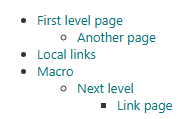Confluence® page tree is an essential part of navigation across the entire Conference® space. Page tree is located on the left side of a Confluence® layout. The page tree is dynamic. Its area can be expanded to different width or collapsed altogether. The number of levels in page hierarchy is not limited. Page tree can have an arbitrary depth. Every level in a tree can be expanded or collapsed to show or hide all the pages, which belong to this level. In this way you can easily navigate to different levels of tree structures by going through hierarchical tree levels.

In contrast to Confluence®, SharePoint® does not include standard page tree component. Navigation in SharePoint® is going through direct linking across different pages by inserting into them links to other pages. This crucial difference complicates transfer of the structure from the Confluence® to SharePoint® and user experience in new environment after migration. Users who are familiar with Confluence® page tree can be confused this new navigation experience offered by SharePoint®.
Enterprise Bridge offers multiple approaches to facilitate the transfer of the data between environments and simplify and simplify accommodation of users to new environment after migration. At least three different approaches can be adopted in regards to Confluence® page tree migration.
Built-in Page Tree in SharePoint
The first approach concerns the native page present in SharePoint®. Many users are not aware that SharePoint® offers native page tree navigation. It can be easily activated through navigation options in standard site settings. 
Major disadvantage of this approach is limitation to only classical SharePoint® sites. The standard page tree cannot be rendered in this way on modern communication sites. Probably for this reason this page tree is not enabled by default on a SharePoint® site. Appearance of this tree is also not perfect because it presents not only tree of pages but also shows hierarchy official site content including page list, document libraries and other side areas. Despite these evident disadvantages, the standard page tree can be handy in many use cases what is a standard SharePoint® feature.
Embedded navigation blocks of page links
Due to deficiencies of the standard page tree in SharePoint®, Enterprise Bridge offers its own way of navigation across the migrated content. Navigation is provided through special blocks of links embedded directly into every migrated page.

The block of links is normally inserted at the bottom of the page. However this default location can be easily changed to another area at the top or on a side of the page or into any other area depending on user preferences.
The content of this block of links is dynamic. For example, on a homepage it renders the entire page tree of the migrated site expanded to all page levels, which gives direct access to any page on the site. Further on sub-pages the structure splits into two areas.

At the top of the page appears so called breadcrumbs area, which provides quick navigation to upper levels of the page tree. This naturally replicates breadcrumbs functionality found originally in Conference®. In turn, block of links at the bottom are shanks from the whole tree to only three of sub-pages located below the current page in the page hierarchy. this navigation option closely follows original conference concept and is universally compatible is all types of SharePoint® sites and all SharePoint® versions.
React Pages Hierarchy
Dynamic page tree in SharePoint® similar to Confluence® can be created using special web part, React Pages Hierarchy, which is open source component available on GitHub as a part of PnP framework
https://github.com/pnp/sp-dev-fx-webparts/tree/main/samples/react-pages-hierarchy

If React Pages Hierarchy is present on a web site, Enterprise Bridge can populate it with exact copy of page tree, which existed in Confluence®. Enterprise Bridge inserts React Pages Hierarchy into every page on the site during migration. For all aspects of usage of React Pages Hierarchy please refer to documentation of this web part and relevant support forums.
